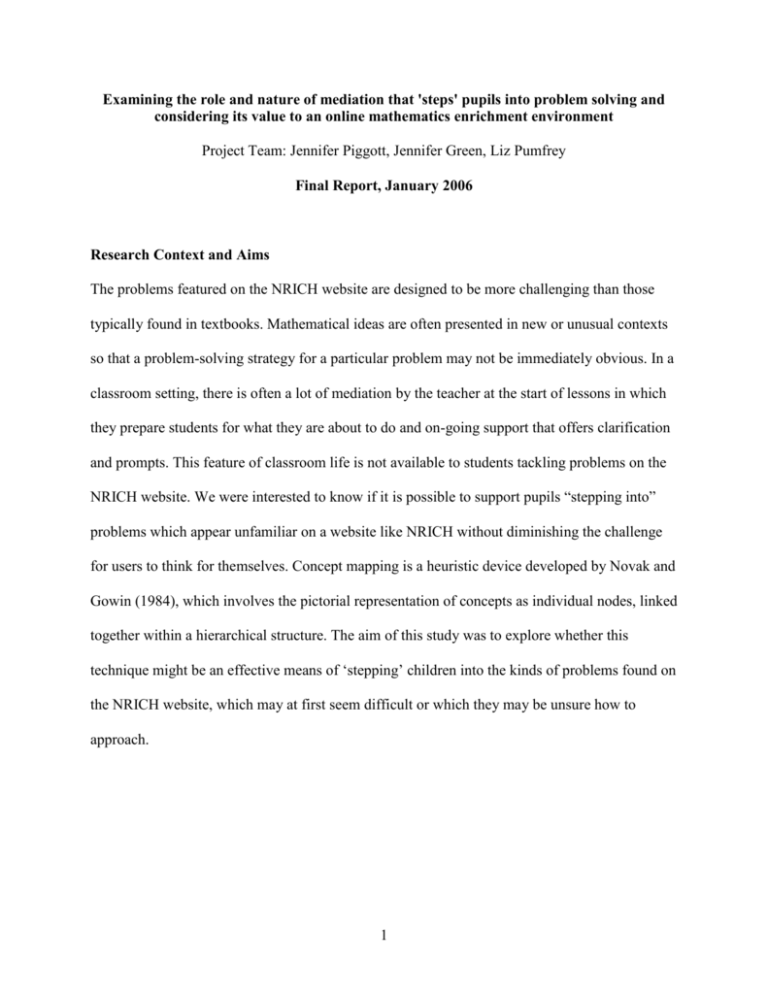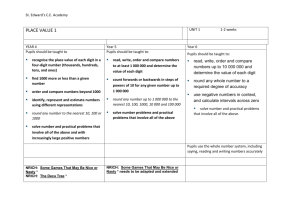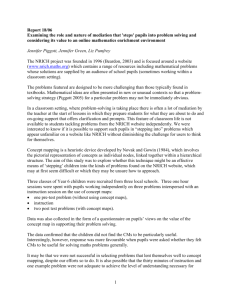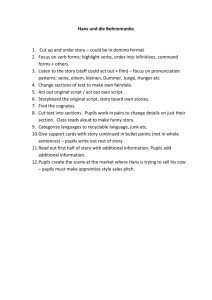Examining the role and nature of mediation that `steps` pupils
advertisement

Examining the role and nature of mediation that 'steps' pupils into problem solving and considering its value to an online mathematics enrichment environment Project Team: Jennifer Piggott, Jennifer Green, Liz Pumfrey Final Report, January 2006 Research Context and Aims The problems featured on the NRICH website are designed to be more challenging than those typically found in textbooks. Mathematical ideas are often presented in new or unusual contexts so that a problem-solving strategy for a particular problem may not be immediately obvious. In a classroom setting, there is often a lot of mediation by the teacher at the start of lessons in which they prepare students for what they are about to do and on-going support that offers clarification and prompts. This feature of classroom life is not available to students tackling problems on the NRICH website. We were interested to know if it is possible to support pupils “stepping into” problems which appear unfamiliar on a website like NRICH without diminishing the challenge for users to think for themselves. Concept mapping is a heuristic device developed by Novak and Gowin (1984), which involves the pictorial representation of concepts as individual nodes, linked together within a hierarchical structure. The aim of this study was to explore whether this technique might be an effective means of ‘stepping’ children into the kinds of problems found on the NRICH website, which may at first seem difficult or which they may be unsure how to approach. 1 Methods Three classes of Year 6 children were recruited from three local schools. Each class consisted of between 18 and 30 pupils, and there were 75 pupils in all. A single morning was spent collecting data in each school, which was divided into 3 one-hour sessions spent with each class as a whole. Children were informed that we were from the NRICH website, and that we were going to ask them to try out some of our problems and then let us know what they thought of them in brief questionnaires. They were told that there would be three problems they would work on individually (for 25 minutes each) and one we would do together as a group. We did not mention concept maps (CM) in this introduction. Pupils were asked to work on the first problem individually and requested to resist the temptation to confer with their classmates. Next children were given a 30-minute instruction session on concept mapping during which a sample problem was used to demonstrate how a CM might be used to work through a problem. For the purposes of this study, a ‘starter concept map’ was created, which contained two starting nodes (‘what I know’ and ‘what I need to know’) as well as four prompts (e.g. ‘I could try…’, ‘It reminds me of…’) to help children think about what information they might put in their maps. After the instruction session, the second and third problems were distributed along with the blank starter maps which pupils were encouraged to use to help them work through the problems. After spending 10 minutes on the problems, children were reminded that the maps were there to help them, to be sure they did not simply forget to use them. The position of each test problem in the order was rotated so that if problem A was the first (or ‘pre-test’) problem in one school, it was the second problem in the next school, and the third in the next. The same sample problem was used in all three schools. 2 After each of the three test problems, a brief, one-page questionnaire was distributed which was designed to assess what pupils thought of each problem - how difficult they found it, whether they knew how to solve it, understood directions instructions???, etc. The questionnaires for the third and fourth problems (those presented after the CM instruction session) included a question about whether they felt the concept map to have been helpful. Additionally a two-page questionnaire was presented at the end of the last session, which aimed to assess pupils’ attitudes toward concept mapping generally, and the extent to which they had found them to be helpful. In two of the three schools, a brief question session was conducted in which children were asked for their opinions on the problems and on concept mapping. Results and Discussion It was originally planned that children’s performance on the pre-test problem (without CM) would be compared with their performance on the post-test problems (with CM), to see whether using the maps affected their performance. However in the event, so few children actually created maps that such an analysis was deemed to be impracticable. Each of the 75 children had two chances to make a map as there were two post-test problems. Of these 150 possible maps, 111 were returned completely blank. Of the 39 maps that were actually utilised, 25 had only one or two marks. It was not surprising, therefore, to learn from the questionnaire data that children did not find the CMs to be particularly useful. Table 1 summarises pupils’ response to questionnaire items in which they were asked to rate how helpful or useful they found concept mapping to be. Only a 3 very few reported finding the maps useful. Interestingly, however, response was more favourable when pupils were asked whether they felt CMs to be useful for solving maths problems generally. Table 1 – Perceived usefulness of concept mappings a) with respect to individual problems and b) more generally. a) Did you find making the 1 (not at all) 2 (a little) 3 (somewhat) 4 (helpful) 5 (very helpful) 68% 21% 7% 4% 0% Problem B 71% 19 % 4% 6% 0% Problem C 76% 18% 2% 4% 0% 1 (not at all) 2 (a little) 3 (somewhat) 4 (useful) 5 (very useful) 60% 23% 10% 7% 0% 17% 41% 19% 23% 0% concept map helpful for working through this problem? Problem A b) How useful… …did you find concept mapping today? … do you think concept maps are for solving maths problems? In addition to saying whether they found the CM to be useful with each post-test problem, pupils were provided with space to explain the reasons for their answer in their own words. Table 2 shows the kinds of reasons provided for not finding the concept maps to be helpful. The most common response was ‘I didn’t need it’, or ‘I already knew what to do’. Less common but related responses were variations of ‘it was easier to do in my head’ and ‘it was easier to just to try things out’. The second most common response was ‘I didn’t understand how to do concept mapping’. 4 Table 2 – Children’s reasons why concept maps were not found to be helpful. didn't need it / knew what to do didn't understand concept mapping don't know / just didn't easier to just try things out not useful with this problem too time consuming didn't know how to start easier to do problem mentally found problem difficult CM makes it harder /confusing TOTAL Prob A 14 10 6 5 4 1 1 1 1 2 45 Prob B 9 8 8 5 2 3 3 2 2 1 43 Prob C 16 5 7 3 5 4 1 2 0 0 43 TOTAL 39 23 21 13 11 8 5 5 3 3 131 % 30 18 16 10 8 6 4 4 2 2 100 It may be that we were not successful in selecting problems that lent themselves well to concept mapping, despite our efforts so to do. It is also possible that the thirty minutes of instruction and one example problem were not adequate to achieve the level of understanding necessary for children to make effective use of the maps. Response to a questionnaire item asking how well children felt they understood concept mapping almost half of the children (48%) reported understanding concept mapping ‘well’ or ‘very well’. About the same proportion of children (47%) said they felt they had learned enough to make a CM on their own. The feedback received from the participating pupils, along with the fact that almost no maps were actually produced, would suggest that concept mapping would not be an appropriate mediation tool for the NRICH website. Reference Novak, J. & Gowin, D.B. (1984) Learning How lo Learn. Cambridge University press, Cambridge. 5




![afl_mat[1]](http://s2.studylib.net/store/data/005387843_1-8371eaaba182de7da429cb4369cd28fc-300x300.png)






